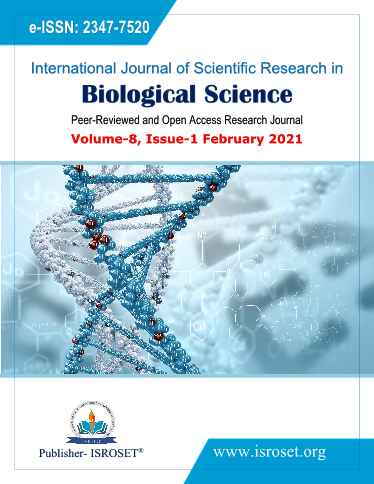Prevalence of Plasmodium Infection in District Multan, Punjab, Pakistan
Keywords:
ICT, Thick and Thin smear, Plasmodium vivax, Prevalence, P.falciparumAbstract
Background: Plasmodium infection (Malaria) always remains hazardous for its fatalities worldwide, especially for Pakistan; it is yet endemic in many areas. Out of five types, Plasmodium vivax and Plasmodium falciparum is dominating in Pakistan. P. vivax is more frequent and widely distributed while P. falciparum is more dangerous and deadly in action. This research was conducted for the assessment of Plasmodium infection frequency in human populations of District Multan, Punjab, Pakistan. Methods: Plasmodium type was identified in the blood of high graded fever patients. Immunochromatographic Technique (ICT) as well as thick and thin blood smears procedure was performed at different laboratories of district Multan where the microscopic examination was carried out for the presence of Plasmodium types and its species. Results: Statistically, the current prevalence and distribution of Plasmodium types was estimated in this work. A total of 192 blood samples were examined. The species recovered were P.vivax, P.falciparum and mixed species. The prevalence of P.vivax, P.falciparum and mixed species was 13.02%, 10.41% and 1.041% respectively. Conclusion: Plasmodium vivax had prevalence over Plasmodium falciparum. The number of prevalence species was greater more in males than females. The age-wise prevalence of plasmodium infection revealed that age group 21-30 years had more prevalence over other age group.
References
World Health Organization. World malaria report 2015. World Health Organization; pp.40, 2016.
World Health Organization. World Malaria Report 2018 (World Health Organization, Geneva, Switzerland,pp.38, 2018).
Cox FE. History of the discovery of the malaria parasites and their vectors. Parasites & vectors, Vol.3, Issue.1, pp.1-9, 2010.
Celli-Fraentzel A. “The History of Malaria in the Roman Campagna from Ancient Times. The History of Malaria in the Roman Campagna from Ancient Times,” John Bale, Sons & Danielsson Ltd, London, UK, pp.226-239, 1933.
Gachelin G, Garner P, Ferroni E, Tröhler U, Chalmers I. Evaluating Cinchona bark and quinine for treating and preventing malaria. Journal of the Royal Society of Medicine. Vol.110, Issue.1, pp.31-40, 2017.
Soomro FR, Pathan GM, Gurbakhshani AL, Kakar JK. Prevalence of malarial parasites in Larkano district, Sindh, Pakistan. Gomal Journal of Medical Sciences,Vol.8, Issue.2, 2010.
Patz JA, Hulme M, Rosenzweig C, Mitchell TD, Goldberg RA, Githeko AK, Lele S, McMichael AJ, Le Sueur D. Regional warming and malaria resurgence. Nature, Vol.420, Issue.6916, pp.627-628, 2002.
Snow RW, Guerra CA, Noor AM, Myint HY, Hay SI. The global distribution of clinical episodes of Plasmodium falciparum malaria. Nature,Vol.434, Issue.7030, pp.214-217, 2005.
Bouma MJ, Dye C, Van der Kaay HJ. Falciparum malaria and climate change in the northwest frontier province of Pakistan.The American journal of tropical medicine and hygiene,Vol.55, Issue.2, pp.131-137, 1996
Ghanchi NK, Shakoor S, Thaver AM, Khan MS, Janjua A, Beg MA. Current situation and challenges in implementing malaria control strategies in Pakistan. Critical reviews in microbiology,Vol.42, Issue.4, pp.588-593, 2016
Nyunt MH, Kyaw MP, Win KK, Myint KM, Nyunt KM. Field evaluation of HRP2 and pan pLDH-based immunochromatographic assay in therapeutic monitoring of uncomplicated falciparum malaria in Myanmar. Malaria journal,Vol.12, Issue.1, pp.1-8, 2013
Hartmeyer GN, Stensvold CR, Fabricius T, Marmolin ES, Hoegh SV, Nielsen HV, Kemp M, Vestergaard LS. Plasmodium cynomolgi as cause of malaria in tourist to Southeast Asia, 2018. Emerging infectious diseases,Vol.25, Issue.10, pp.1936, 2019.
Tasawer Z, Mannan F, Arif BA. Prevalence of human malaria at Multan. Pak J Med Sci,Vol.3, Issue.2, pp.123-126, 2003.
Douglas NM, Nosten F, Ashley EA, Phaiphun L, Van Vugt M, Singhasivanon P, White NJ, Price RN. Plasmodium vivax recurrence following falciparum and mixed species malaria: risk factors and effect of antimalarial kinetics. Clinical Infectious Diseases,Vol.52, Issue.5, pp.612-620,2011.
Tareen AM, Rafique M, Wadood A, Qasim M, Rahman H, Shah SH, Khan K, Pirkani GS. Malaria burden in human population of Quetta, Pakistan. European Journal of Microbiology and Immunology,Vol.2, Issue.3, pp.201-204, 2012.
Soomro FR, Pathan GM, Gurbakhshani AL, Kakar JK. Prevalence of malarial parasites in Larkano district, Sindh, Pakistan. Gomal Journal of Medical Sciences,Vol.8, Issue.2, 2010.
Patz JA, Olson SH. Climate change and health: global to local influences on disease risk. Annals of Tropical Medicine & Parasitology,Vol.100, Issue.5-6, pp.535-549,2006.
Strickland GT, Zafar-Latif A, Fox E, Khaliq AA, Chowdhry MA. Endemic malaria in four villages of the Pakistani province of Punjab. Transactions of the Royal Society of Tropical Medicine and Hygiene, Vol.81, Issue.1, pp.36-41,1987.
Reiter P. The standardised freight container: vector of vectors and vector-borne diseases. Revue Scientifique et Technique (International Office of Epizootics),Vol.29, Issue.1, pp.57-64,2010.
McKenzie FE, Bossert WH. Mixed-species Plasmodium infections of humans. The Journal of parasitology,Vol.83, Issue.4, pp.593,1997.
McKenzie FE, Bossert WH. Multispecies Plasmodium infections of humans. The Journal of parasitology,Vol.85, Issue.1, pp.12,1999.
Tareen AM, Rafique M, Wadood A, Qasim M, Rahman H, Shah SH, Khan K, Pirkani GS. Malaria burden in human population of Quetta, Pakistan. European Journal of Microbiology and Immunology,Vol.2, Issue.3, pp.201-204,2012.
Beck-Johnson LM, Nelson WA, Paaijmans KP, Read AF, Thomas MB, Bjørnstad ON. The effect of temperature on Anopheles mosquito population dynamics and the potential for malaria transmission. PLOS one. Vol.8, Issue.11, pp.e. 79276,2013
Downloads
Published
How to Cite
Issue
Section
License

This work is licensed under a Creative Commons Attribution 4.0 International License.
Authors contributing to this journal agree to publish their articles under the Creative Commons Attribution 4.0 International License, allowing third parties to share their work (copy, distribute, transmit) and to adapt it, under the condition that the authors are given credit and that in the event of reuse or distribution, the terms of this license are made clear.







